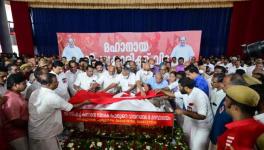Regional Airports in India: Policy Without Planning
India has a reputation for announcing policies that are poorly conceived, insufficiently thought through and badly implemented, and which later run into huge problems causing losses to both stakeholders and the public, often leaving both the policy itself and the targeted sector in shambles.
The Naresh Chandra Committee on Civil Aviation submitted a comprehensive Report in 2004, some recommendations from which have been cherry-picked and implemented in bits and pieces. The Ministry of Civil Aviation (MoCA) Consultation Paper in early 2012 on air connectivity to regional, remote and inaccessible areas of the country is another glaring example. Comments were sought but, almost a year afterwards, one does not know if there is in fact a firm Policy in place and, if so, what this policy is.
Yet various action plans and projects continue to be announced in an ad hoc manner. For instance, the Minister of Civilian Aviation announced at a Meeting of the Parliamentary Consultative Committee of his Ministry in December 2012 that steps were being taken to liberalize procedures regarding new regional airports, and that air connectivity with smaller cities and towns would be enhanced. Earlier in October, the Minister had declared that approval had been granted for 15 greenfield airports including a new metro airport in Navi Mumbai and regional airports in Mopa (Goa) and Kannur where work was expected to commence within this financial year.
Whatever the merits or otherwise of these three airports, problem is that such random statements and ad hoc announcements do not constitute a policy. Regional airports require careful consideration of various developmental aspects with long-term implications. Criteria for deciding on new airports also need to be clearly spelled out and projects cleared taken transparently so as to guide investors, planners, administrators, regulators and other stakeholders. Otherwise any so-called policy not only remains hollow, but also dangerously allows all kinds of ad hoc actions in a framework that encourages arbitrary decision-making by authorities.
New regional airports will mean a lot of money changing hands in large projects for infrastructure firms and myriad contractors, and new opportunities for many businesses. Airports are also seen by many politicians as prestige projects for their states, constituencies or home towns. The doors to cronyism and favouritism will be wide open.
Given the policy vacuum, there is serious danger of vanity projects, over-capacity in airport and allied infrastructure, and non-viability of many regional airports with attendant pressure on the state to subsidize a particular form of transportation, that too one used by upper-income sections of society. This would further skew transportation policy in India away from mass transportation for the general especially lower-income public, negatively impact fuel economy and also increase greenhouse gas emissions.
Over-projection It is a widely accepted notion, although requiring qualification as seen later, that civil aviation promotes wider economic development by increasing efficiencies in manufacturing and commerce, boosting tourism with its known large multiplier effects, and creating ancillary jobs in many sectors. Within this framework, regional airports are expected to help reduce regional disparities and structural backwardness especially of remote regions, and promote cultural exchange and national integration.
Air traffic growth in India over the past decade in terms of both passengers and freight has been truly impressive. Passenger and freight traffic have been growing at 12-15% per year at roughly double GDP growth rates. Liberalization of civil aviation and its opening up to the private sector, combined with pent-up demand, saw mushrooming of private carriers, lowering of air fares and dramatic growth in passenger traffic including to smaller towns and regional hubs. Ambitious plans began to unfold to expand infrastructure and official target to raise India from its present 9th position to the top five in global aviation in the 12th Plan period. Despite the slight slump currently in passenger growth rates, Government agencies have projected that around 500 airports in all, both brownfield and greenfield, would be required by 2020. The private sector is sought to be involved in a big way through different PPP models, all of which still involve substantial state support in terms of part financing, concessional land allotment, tax holidays and other incentives.
But there seems to be a big gap between reality and these dreams.
At present, the Airports Authority of India (AAI) runs a total of just 115 airports, of which only 71 are commercially operational and the rest are lying closed, chiefly due to non-viability. Only a handful of AAI airports are running at a profit. While the new airports at Bangalore and Hyderabad, and the upgraded ones at Mumbai and Delhi, are run by private operators in joint ventures with state agencies, AAI has directly embarked on upgradation of Kolkata and Chennai airports and 35 non-metro airports through the PPP mode. But there continues to be considerable uncertainty about even the handful of greenfield airports already initiated and planned over the next few years.
Cushy playing fields Nevertheless, given the projections and the eagerness of government to bring in private players and possibly FDI, construction, infrastructure and realty corporates, along with engineering and financial consultancy companies, are excited and looking to get in on the ground floor. Also expectedly, these corporates are not only eagerly grabbing opportunities now being offered up, they are also tom-tomming inflated growth predictions and lobbying for rapid expansion and more favourable terms.
For instance, Regional Airport-Holdings International (RAHI) Ltd, a joint venture led by ILFS, a major player in transportation infrastructure and finance, has announced plans to invest over Rs.3000 crore in 15 airport projects over the next 5 years. RAHI with other partners is already involved in India’s first greenfield regional airports in Gulbarga and Shimoga in association with the Karnataka government. The Shimoga project involves 567 acres of land acquired by the state government and leased out for 30 years at Rs.86 lakhs annually, with the developers free to utilize about 322 acres for non-aviation purposes such as industry clusters and other projects including an aviation institute. The terms are broadly similar at Shimoga, the home town of then Chief Minister B.S.Yeddyurappa who treated this as a pet project. Investment though is only one side of the story, passenger and cargo traffic, and general viability, being the other.
Sceptics point to the poor performance of Mysore airport, revamped by AAI in 2010 in Karnataka’s second largest city. The Karnataka government not only provided Rs.100 crore towards land acquisition but also subsidy of Rs.25 crore over and above the Rs.86 crore cost incurred by AAI. At the inauguration, the CM expressed optimism based on the 25 lakh tourists visiting Mysore annually and its over 15,000 Infosys employees. Then Union Law Minister Veerappa Moily, also from Karnataka, added that the central government is slated to provide around Rs.40,000 crore to the aviation sector over the next few years and called upon State governments to avail this bounty.
However, only one airline chose to operate from Mysore, flying around 10,000 passengers in 2011. The airport was closed in November that year. Operations are being resumed next week through a thrice-weekly flight to Bangalore.
AAI was left holding the baby, but nobody knows if AAI actually favoured the project. But what would happen if such a fate befell a private operator?
One company, Reliance Airport Developers Pvt Ltd, came up with a wish list to ensure viability of privately operated regional airports. Recognition by government that such airports are “national assets” deserving of continuous support, especially subsidies as provided for air traffic to the North-East; assurance from airlines that they would continue operations; exemptions from various taxes; and governmental promotion of SEZs, large industries, tourism and other projects in the area. If government has to do all this, then why have an airport there at all, or why should AAI itself not also build and run the airport?
Answer perhaps lies outside aviation. Experience of some privately operated airports such as in Delhi shows that the city-side business is a major factor attracting investors, and that there is much corner-cutting and cronyism involved in obtaining additional land and securing permits for all kinds of businesses. The Minister’s recent announcement includes a decision to remove any need to obtain AAI approval for any city-side project within the allotted airport land. Whether municipal bodies will be consulted is anybody’s guess. Greater value may lie in manipulating airport concessions for real estate deals than from airport operation itself.
Criteria for airport location Many of these and other kinds of uncertainties and arbitrariness can be done away with if clear criteria are adopted and actually used to decide on and implement regional airport projects, and what should be expected from them.
It is always argued, with some justification, that civil aviation in both passenger and goods, makes a significant contribution to economic development in that region as well as nationally. The International Civil Aviation Organization (ICAO) estimates that $100 of air transport expenditure produces $325 of benefits and 100 additional jobs in air transport results in 610 new economy-wide jobs. ICAO attributes over 4.5% of global GDP to the air transport component of civil aviation which provides several multiplier effects. However, the idea that creating civil aviation infrastructure will somehow by itself drive economic development is simply not true.
Attractive tourist spots, remote locations especially, would obviously benefit enormously from air connectivity provided, of course, adequate tourist infrastructure exists or comes up quickly. The examples of Bali and tourist hot spots in Thailand are often cited as examples. With a very few notable tourism destinations, however, India as a whole has failed to attract large numbers of international tourists. Annual arrivals are currently around 5 million a year, a meager 0.5% of global tourist traffic, less than a third of much smaller Thailand and only one-tenth of China. Analysts are unanimous that this is due mostly to weaknesses in infrastructure such as accommodation and amenities of varied price ranges, communications, and tourist attractions. An airport will not make these happen. Similarly, industrial or commercial development will be boosted by a local airport, but will not happen solely because of one.
One of the very few tangible criteria actually spelled out in the airports policy is that connectivity with state capitals will be promoted. This may be politically desirable but it might not have great economic rationale or even passenger appeal in all cases. Many airports in state capitals in India have quite low traffic, but may well qualify for some state support on grounds of broader social good.
Another important criteria is remoteness and inaccessibility of otherwise important and commercially potential locations, and the social desirability of air access for people and goods. Air connectivity to the North-East has for long been promoted on this basis, including through direct and cross subsidies. Such social cost borne by the state, albeit transparently and in a manner that does not penalize public sector airlines or airports, is clearly justifiable. Flights to the North-East have gone up in recent times from 87 to 286 flights per week, and Agartala has twice the passenger traffic of Bhopal. The new greenfield airport being built by AAI in Pakyong, Sikkim, will undoubtedly benefit this remote state immensely and the nation by promoting its integration. The boost to tourism, the local economy and residents of Lasakh due to air connectivity of Leh is immeasurable.
But it is a gross misinterpretation, perhaps even a willful distortion, to club together airports in “regional, remote and inaccessible areas of the country,” as the very title of the Consultation Paper does. New regional airports in the mainland cannot be justified by the legitimacy of connectivity to hinterland areas, but need a clear and integrated policy frame.
Integrated view required The EU has a well-developed set of criteria approved by the European parliament. In general, the EU favours economically viable regional airports catering to around 500,000 passengers a year, a general rule-of-thumb figure for airport viability. The EU recognizes the need for state support for air connectivity to “remote, inaccessible and island locations” but which need to be “strictly defined and transparent.” It stresses the need to “avoid a proliferation of regional airports” as that would run “counter to efficiency and sustainability criteria.”
A more integrated view of regional airports as part of a larger national transportation system and policy frame, as recommended by the EU, would also enable more rational and cost effective decisions. One of the reasons why Dehradun, Mysore or even Bhopal airports have comparatively low passenger traffic is that they are well connected by rail and road. Even if regional airports are built in Tier-II or Tier-III cities, absence of good road or rail connectivity would undermine their utility. Conversely, if good surface connectivity were made available, the very need for some regional airports may be obviated.
Even from the point of fuel economy, energy efficiency and emissions reduction, prolific or unplanned expansion of regional airports and air transportation are undesirable. The UK for instance, with high petrol costs and high rail fares after privatization, has seen a jump in internal air traffic which is estimated to account for about 70% of the country’s emissions quota. Air transport is estimated to be responsible for 3-5 times the emissions of rail travel per passenger-km. An upgraded rail network, linkages with which Indian airports sorely lack unlike other medium-income countries, would throw a very different light on the need for regional air connectivity.
India needs to consider the pros and cons of regional airports carefully. A cogent policy must be evolved, with clear criteria for new projects as well as an independent, effective and transparent mechanism for approving these. Regional airports should certainly not be viewed as vanity projects or as vehicles for cronyism involving favoured infrastructure developers and builders.
Get the latest reports & analysis with people's perspective on Protests, movements & deep analytical videos, discussions of the current affairs in your Telegram app. Subscribe to NewsClick's Telegram channel & get Real-Time updates on stories, as they get published on our website.
























